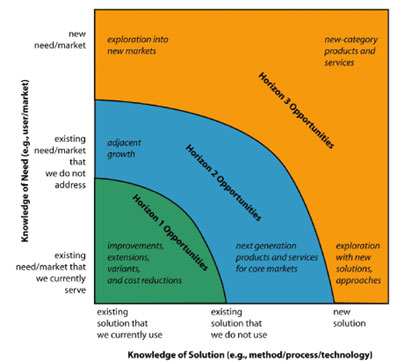Innovation is one of the key strategies for almost any companies who want to stay competitive, and grow business. It is used as both a defense weapon, to fend off competitions and disruptions, and an offence weapon, to attack and gain market share.
According to Terwiesch and Ulrich [1], innovation can be categorized into 3 horizons, as illustrated in the below figure.

For companies that seek strong growth, break into new market, or stay competitive with the emerging technologies, opportunities in Horizon 2 offer them balanced rewards and risks. Companies could offer new solutions to their current market, customer base, or bring their successful products or services to the neighboring market or customer segments. With either known customers or solutions, Horizon 2 innovations give companies certain predictability and control, while bringing in brand new revenue stream and diversifying companies’ product or service portfolio.
These sound very exciting and promising, but for companies historically stayed with Horizon 1 opportunities, to enter into Horizon 2 and be successful, there are strategic commitment and operational details to focus on.
Strategic Commitment: Innovation is a leading indicator for company’s future growth. It rarely brings in immediate outcome in revenue growth or market expansion. This is especially true for Horizon 2 innovations. Companies used to stay in Horizon 1 may have Return of Investment (ROI) formula that measures immediate or short-term revenue return. The leadership will be disappointed that Horizon 2 opportunities may not have a good-looking ROI for the first few years. Company leadership needs to make long-term commitment, stay focused, be patient and keep the investment. We will discuss how to measure Horizon 2 ROI at the end.
Centralized Innovation Organization: Companies in Horizon 1 often see innovations originated within their business units and driven by the project teams. To expedite Horizon 2 innovations and bring to the market new solutions faster, it is often more effective that the company consolidates its innovation functions under a centralized organization. Such organization is often led by the Chief Technology Officer, or the Chief Innovation Officer, with clearly defined roles, responsibilities and budget to strategize, plan, develop and prepare go-to-market of innovative products or services. Under this C-level leadership, there is an innovation team, staffed with members in product management, project management and development. The team may consider staffing marketing and sales personnel or share these functions with the corporate marketing and sales team. The company may also consider bringing in external resources to provide surge support on innovation effort, for example, hiring college interns, or using crowd sourcing for part of the function development.
Innovation Culture: It is imperative to build a culture that promotes and rewards innovation. Companies should have their executives communicate innovation regularly. They could institute innovation days that give staff time off to focus on innovation efforts; They could host innovation hackathons, business case competitions, innovation brownbag sessions that promote and collect innovation ideas; They could also selectively participate into industry innovation competitions to raise the profile of the company innovation in the marketplace. To reward staff for innovation, companies may issue spot bonus, monthly, quarterly or annual innovation awards. They could also add innovation as an evaluation criteria for performance review, merit increase or promotion.
Innovation Portfolio Investment and Management: Innovation often involves trial and error. It is a journey to convert from an idea to a successful innovative product or service that people are willing to buy. Many such journeys will lead to dead-end and failure. Companies should borrow venture capitalist approach in investing start-ups, fund multiple innovation ideas, and allow teams to explore these ideas, while closely manage them as a portfolio, evaluate them via multiple stage-gate reviews so that unfit efforts can be stopped through the process. Depending on which stage in the process, the evaluation criteria could include addressable market, potential revenue, technical feasibility, possibility of obtaining patent, level of effort, cost, risks, time-to-market, revenue forecast, etc.
Close Alignment with Other Corporate Functions: Innovation is a team effort, and it should not be siloed within the innovation team. The innovation team should work closely with business development, marketing, project, finance, legal, HR and other functions throughout the innovation process to strategize, plan, develop, promote and manage innovation.
ROI Measurement: Innovations in Horizons 2 often won’t bring immediate revenue return. Using short-term revenue-based ROI measurements may lead to prematurely stop an innovation with great potential. Companies may employ a balanced scorecard approach on innovation ROI, and measure both tangible (revenue, profit, etc.) and intangible (patent, award, customer impression, etc.) benefits. In the early stage of an innovation, the intangible benefits may have bigger weight in the balanced scorecard and the weight will gradually be reduced and more weight will be given to the tangible benefits.
To measure revenue-based ROI, McKinsey [2] proposed 2 rolling average calculations. 1) 5-year rolling average of the ratio of innovation investment is converting into new product sales; or 2) 5-year rolling average of product-to-margin conversion metric.
In summary, innovation can be a strategic asset and brings competitive edge for companies if managed and measured strategically. Companies should make long-term commitment, and should focus holistically on their people and process aspects to bring technology innovation to the market successfully.
[1] “Innovation Tournaments: Creating and Selecting Exceptional Opportunities,” Christian Terwiesch, Karl T. Ulrich, Harvard Business Review Press, May 14, 2009. https://a.co/d/88QZOaF
[2] “How to take the measure of innovation,” McKinsey & Company, October 2018. https://www.mckinsey.com/~/media/mckinsey/business%20functions/strategy%20and%20corporate%20finance/our%20insights/how%20to%20take%20the%20measure%20of%20innovation/how-to-take-the-measure-of-innovation-vf.pdf?shouldIndex=false












